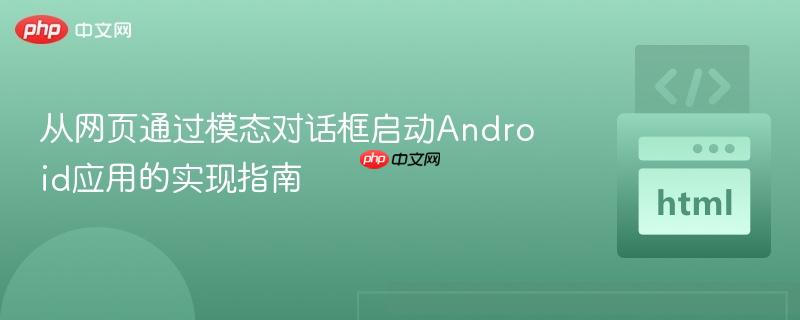
本文详细介绍了如何通过在网页上实现一个用户确认模态对话框来启动android应用程序。教程涵盖了html结构、css样式以及javascript逻辑,旨在创建一个自定义的确认提示,允许用户在启动应用程序前进行明确选择,从而提升用户体验并增强对网页应用启动行为的控制。
在网页中直接通过Intent URI启动Android应用是一种常见的交互方式。然而,这种直接跳转有时会给用户带来困惑,尤其是在用户不确定是否要离开当前网页时。引入一个模态对话框(或称作弹窗)作为中间确认步骤,可以显著改善用户体验。它允许用户在明确同意后才启动应用,同时提供取消选项,避免了意外跳转,并能在应用未安装时提供更好的反馈机制。
实现带有确认对话框的网页应用启动,主要依赖于以下技术:
首先,我们需要在网页中添加一个按钮来触发应用启动流程,以及模态对话框的HTML结构。
<!DOCTYPE html>
<html lang="zh-CN">
<head>
<meta charset="UTF-8">
<meta name="viewport" content="width=device-width, initial-scale=1.0">
<title>从网页启动Android应用示例</title>
<link rel="stylesheet" href="style.css">
</head>
<body>
<h1>点击按钮启动Android应用</h1>
<button id="openAppButton">打开我的Android应用</button>
<!-- 模态对话框结构 -->
<div id="appLaunchModal" class="modal">
<div class="modal-content">
<span class="close-button">×</span>
<h2>确认启动应用</h2>
<p>您确定要打开此Android应用程序吗?</p>
<div class="modal-actions">
<button id="confirmLaunch">打开应用</button>
<button id="cancelLaunch">取消</button>
</div>
</div>
</div>
<script src="script.js"></script>
</body>
</html>接下来,为模态对话框添加样式,使其在页面中央浮动,并覆盖其他内容。
/* style.css */
body {
font-family: Arial, sans-serif;
display: flex;
flex-direction: column;
align-items: center;
justify-content: center;
min-height: 100vh;
margin: 0;
background-color: #f4f4f4;
}
h1 {
color: #333;
margin-bottom: 20px;
}
button {
padding: 10px 20px;
font-size: 16px;
cursor: pointer;
border: none;
border-radius: 5px;
margin: 5px;
}
#openAppButton {
background-color: #007bff;
color: white;
}
#openAppButton:hover {
background-color: #0056b3;
}
/* 模态对话框样式 */
.modal {
display: none; /* 默认隐藏 */
position: fixed; /* 固定定位,覆盖整个屏幕 */
z-index: 1000; /* 确保在其他内容之上 */
left: 0;
top: 0;
width: 100%;
height: 100%;
overflow: auto; /* 如果内容过多可滚动 */
background-color: rgba(0,0,0,0.6); /* 半透明黑色背景 */
justify-content: center; /* 水平居中 */
align-items: center; /* 垂直居中 */
}
.modal-content {
background-color: #fff;
margin: auto; /* 自动外边距实现居中 */
padding: 30px;
border-radius: 8px;
box-shadow: 0 4px 8px rgba(0,0,0,0.2);
width: 90%;
max-width: 400px; /* 最大宽度 */
position: relative;
text-align: center;
}
.close-button {
color: #aaa;
float: right;
font-size: 28px;
font-weight: bold;
cursor: pointer;
position: absolute;
top: 10px;
right: 15px;
}
.close-button:hover,
.close-button:focus {
color: #333;
text-decoration: none;
}
h2 {
color: #333;
margin-top: 0;
margin-bottom: 15px;
}
p {
color: #666;
margin-bottom: 25px;
line-height: 1.5;
}
.modal-actions {
display: flex;
justify-content: center;
gap: 15px; /* 按钮之间的间距 */
}
#confirmLaunch {
background-color: #28a745; /* 绿色 */
color: white;
}
#confirmLaunch:hover {
background-color: #218838;
}
#cancelLaunch {
background-color: #dc3545; /* 红色 */
color: white;
}
#cancelLaunch:hover {
background-color: #c82333;
}最后,编写JavaScript代码来控制模态对话框的显示与隐藏,并在用户确认后触发Intent URI。
// script.js
document.addEventListener('DOMContentLoaded', function() {
const openAppButton = document.getElementById('openAppButton');
const appLaunchModal = document.getElementById('appLaunchModal');
const confirmLaunchButton = document.getElementById('confirmLaunch');
const cancelLaunchButton = document.getElementById('cancelLaunch');
const closeButton = appLaunchModal.querySelector('.close-button');
// 定义你的Android Intent URI
// 确保这里的 scheme, host, action 与你的 AndroidManifest.xml 中定义的 Activity 匹配
const androidIntentURI = 'intent://my_host#Intent;scheme=my_scheme;action=my_action;end';
// 显示模态对话框
function showModal() {
appLaunchModal.style.display = 'flex'; // 使用 flex 布局实现居中
}
// 隐藏模态对话框
function hideModal() {
appLaunchModal.style.display = 'none';
}
// 点击“打开我的Android应用”按钮,显示模态对话框
openAppButton.addEventListener('click', showModal);
// 点击“打开应用”按钮,触发Intent URI跳转
confirmLaunchButton.addEventListener('click', function() {
window.location.href = androidIntentURI;
hideModal(); // 尝试隐藏对话框,但跳转后页面会刷新或离开
});
// 点击“取消”按钮或关闭按钮,隐藏模态对话框
cancelLaunchButton.addEventListener('click', hideModal);
closeButton.addEventListener('click', hideModal);
// 点击模态对话框外部区域时关闭对话框
window.addEventListener('click', function(event) {
if (event.target === appLaunchModal) {
hideModal();
}
});
});代码说明:
Intent URI的准确性:确保 androidIntentURI 中的 scheme、host 和 action 与你的Android应用 AndroidManifest.xml 文件中 <activity> 标签下的 <intent-filter> 定义完全匹配。任何不匹配都可能导致应用无法启动。
<!-- 示例 AndroidManifest.xml 配置 -->
<activity android:name=".YourAppActivity">
<intent-filter>
<action android:name="my_action" />
<category android:name="android.intent.category.DEFAULT" />
<category android:name="android.intent.category.BROWSABLE" />
<data
android:host="my_host"
android:scheme="my_scheme" />
</intent-filter>
</activity>应用未安装的Fallback机制:当用户设备上未安装对应的Android应用时,直接通过Intent URI启动可能会失败。不同的浏览器和Android版本处理方式不同,可能表现为页面无响应、显示错误页或提示用户选择应用商店。为了提供更好的用户体验,可以考虑以下Fallback策略:
confirmLaunchButton.addEventListener('click', function() {
window.location.href = androidIntentURI;
// 设置一个延时,作为应用未启动的备用方案
setTimeout(function() {
// 如果应用没有被打开,浏览器可能还在当前页面
// 这里可以重定向到应用商店或提供下载链接
// window.location.href = 'https://play.google.com/store/apps/details?id=your.package.name';
console.log('App might not be installed or did not launch.');
}, 500);
hideModal();
});用户体验优化:
浏览器兼容性:Intent URI主要在Android设备上的浏览器中工作。在iOS设备上,你需要使用Universal Links或Custom URL Schemes(但通常需要额外的配置和处理)。在桌面浏览器上,Intent URI是无效的。因此,在设计时应考虑这些平台的差异。
通过上述HTML、CSS和JavaScript的组合,我们成功地为网页启动Android应用的功能添加了一个用户友好的模态确认对话框。这种方法不仅提升了用户体验,让用户对应用启动拥有更多控制权,而且通过引入Fallback机制,也能更好地处理应用未安装的情况。在实际项目中,务必根据你的Android应用配置和目标用户群体,对Intent URI及Fallback策略进行相应的调整和优化。
以上就是从网页通过模态对话框启动Android应用的实现指南的详细内容,更多请关注php中文网其它相关文章!

每个人都需要一台速度更快、更稳定的 PC。随着时间的推移,垃圾文件、旧注册表数据和不必要的后台进程会占用资源并降低性能。幸运的是,许多工具可以让 Windows 保持平稳运行。

Copyright 2014-2025 https://www.php.cn/ All Rights Reserved | php.cn | 湘ICP备2023035733号